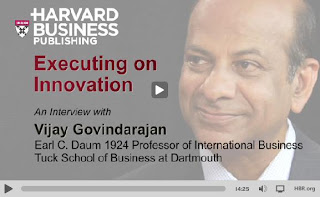Let's start there--with the good. Govindarajan describes the truism that it is the rare organization that lacks the ability to produce new and creative ideas. Far more common is the inability to turn those ideas into action. This is the "other side of innovation" mentioned in his book title, and without it innovation truly doesn't happen. It's one thing to have an idea. It's another to turn that idea into reality.
The same problem plagues many associations. Govindarajan's (and my) advice is fundamentally to start small and build on success. He talks at length about how innovators at IBM created a revolution in computer processing power by implementing this simple formula, and I think the ideas and methods described are directly transferrable to the association environment. Don't try to change the world overnight. You won't be able to do it. Start instead with a bunch of experiments focused on incremental improvement in a wide variety of service areas. Honestly measure the results and reinvest resources dedicated to the losers in the winners and repeat. Doing so builds momentum behind the good ideas and allows for greater and greater leaps to take place with each reinvestment. It works. I've seen it. But it requires the ability to turn things off if they don't go well, something not all associations can do.
So that's a corporate practice that associations can learn something positive from. But some of Govindarajan's other ideas are not worth the same emulation. For example, his innovation prescription for companies is predicated on the idea that you have to separate the innovators from the performers. The people in the trenches, the people actually doing the work, are too busy and too close to the problems to be truly innovative with them. Better, says Govindarajan, to create a separate innovation team, let them tackle the problems and develop creative solutions, and then manage the inevitable conflict that will rise when the innovators try to thrust their ideas on the performers for implementation.
This frankly seems crazy to me. It's a strategy that's definitely biased towards large organizations with large resources at its disposal. Govindarajan admits as much near the end of the video. Some associations may fit that description, but I question whether such a separation is ever a good idea, regardless of the size of the organization.
Bringing in diverse talents and perspectives--that's a good idea. As is generating more ideas and building the capacity for translating the best ones into action. Govindarajan seems to say that those goals are best accomplished by a separate innovation team, but I think it's better to engage your performers in these tasks. It may be more challenging than delegating those jobs to an "external" group of experts, but it also builds a deeper capacity for innovation in your organization. And that's going to pay larger dividends in the long run. Not just in the generation of ideas, but on Govindarajan's other side of innovation as well. Who else, after all, is going to develop the programs and deliver them to your members?


0 comments:
Post a Comment